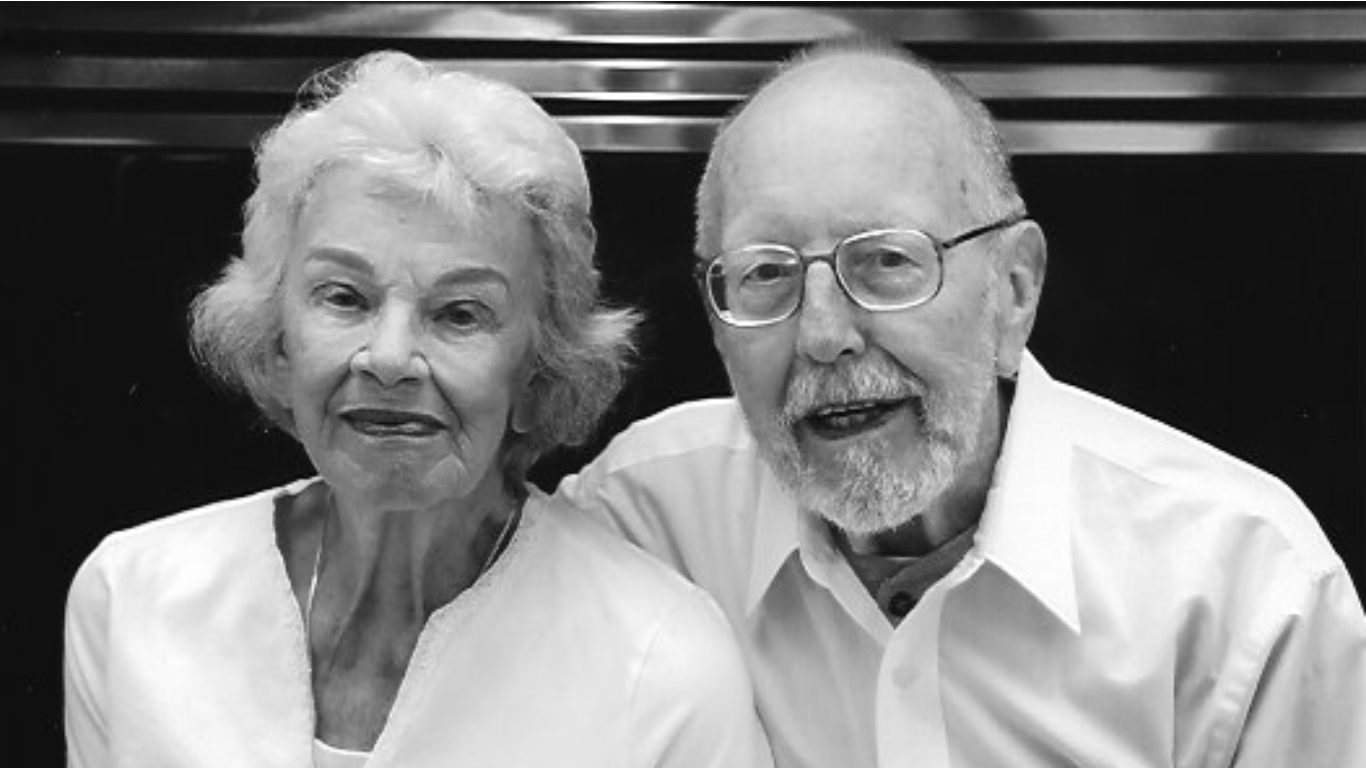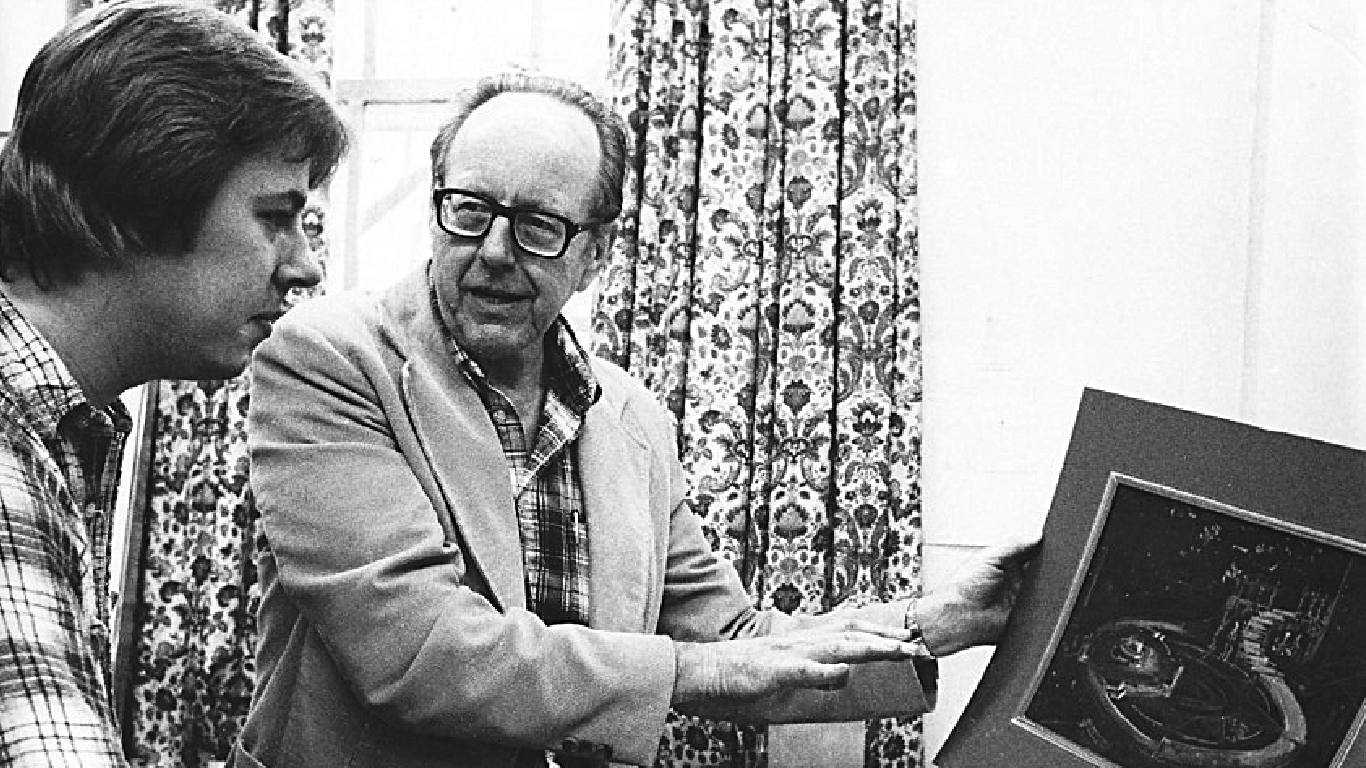Robin Lacy
A life story made for the stage
Professor Emeritus of Theater and Head of Production Design Robin Lacy, EMERT ’85, was known as a passionate scholar about theater production design and a legend among Ohio University School of Theater alumni. The Robin Lacy Memorial Fund honors his legacy by supporting OHIO students. The story that follows is about the man who inspired it. But ultimately, it’s about love. And fate.
Some of us are born with a passion for the arts and know exactly what to do with it.
Robin Lacy, born in 1920, was interested in theater design from childhood. Fast forward to young adulthood. When decisions on where to go to college emerged, Robin enrolled in theater at the University of Denver and quickly began studying production design. Summers were spent at a theater in Central City, Colorado, where he was a scene painter, soaking in the lessons of the professional world that enhance what you learn in the classroom.
It was during this summer when he began spending time with a special woman at the University, another fine arts major named Virginia, who goes by Ginny. Soon, the two were sweethearts.
As gifted artists, they were proud of their own work and each other’s. Yet, Robin was highly ambitious, and with that ambition came ego. When the theater department held a scene painting contest, he felt he should win. Ginny entered the contest too, and the two sweethearts found themselves competing with one another. Ginny won, and his ego took a hit. They bickered and went their separate ways.
History has a funny way about it.
The year was 1942 and WWII was in full swing. One night shortly after graduation, Ginny was at her waitressing job when Robin entered the restaurant. He would be leaving the next day, he said. He had enlisted. He asked Ginny if she would be free later that night, after her shift ended. No, she lied, still feeling bruised. She had a date. Robin turned, exited the restaurant, and entered the war.
Robin joined the United States Army Air Corps, a military arm that evolved into today’s Air Force. He learned how to maintain and repair radio systems. During his training he met a woman named Barbara, and fell in love again. Shortly before he was deployed to India in late 1944, Robin and Barbara married.
After his service in India, Robin transferred to Tinian Island in the Pacific. It was here that Robin witnessed the end of the war when, on August 6, 1945, the Enola Gay took off from Tinian Island carrying the atomic bomb that would destroy Hiroshima. Soon after Japan’s surrender on August 15, Robin returned to civilian life.
Robin quickly restarted the career track he had put on hold, completing a master’s degree in theater at Yale in 1949, taking jobs in TV and theater scene production in New York City, then returning to the University of Denver to pursue a doctoral degree in theater. He taught at Yale until joining OHIO in 1967.
Robin taught lighting design and technical direction, helped to establish the graduate theater program that he would eventually head, and worked diligently for many years on A Biographical Dictionary of Scenographers: 500 B.C. to 1900 A.D., released in 1990 through Greenwood Publishing Group.
“He was a very detail-oriented kind of guy,” says Bob St. Lawrence, former director of the School of Theater. “When I came to Ohio University in the ’70s, I thought I knew everything about technical theater and design. The person who taught me that I didn’t was Rob. We would have lunches where we talked about what I had taught that morning. He would challenge me on everything I took for granted,” he reflects. “It was encouragement to me to really support the things I was teaching. He was my teacher and mentor, as well as the head of my program. To this day, I’m grateful to him. He was a good soul, and he was very supportive of me as a young faculty member and a former fellow theater grunt.”
For 53 years, Ginny kept a drawing Robin made as a gift for her 21st birthday. It was a keepsake she displayed in every house she lived in throughout her adult life.
Associate Professor of Production Design and Technology Daniel Denhart, MFA ’86, credits Robin as the reason he came to OHIO for graduate school.
“One of his former students who was teaching me in Cincinnati, John Gilmore, said, ‘Your assignment today is to drive to Athens and talk to Dr. Robin Lacy about graduate school.’ We met, and hit it off,” Denhart recalls. “I had lots of lighting design experience but wanted to do a whole different area of design. He was okay with that—he took a chance on me—so that’s what I did.”
Robin’s personal life picked up where he had left it. He and Barbara had four children, with Robin teaching and pursuing his passion for railroad history. Between his work at OHIO, his family, and his life, time marched on. Denhart remembers Robin as a serious scholar, yet one with a sense of humor.
“He would always come into the classroom humming operas,” he says about the much-loved professor. “We were expected to know what the operas were, and he would tease us if we didn’t know the answers. We would get together as students and try to see if any of us could guess what they were. That was just one of the games he would work into his teaching.”
Denhart says Robin and Barbara hosted much of the School of Theater’s employees each fall at their home to celebrate the start of the new academic year. “He would always invite everyone to his house: the entire Production and Design faculty, returning students, and incoming students. He was very down to earth and respectful of everybody.”
Robin retired in 1990, concluding 33 years of academic service. He continued to be a regular at theater productions and took an active role in the Ohio University Emeriti Association, having a hand in establishing the University’s Emeriti Park. A tree he planted at the park stands today in memory of his son, a victim of brain cancer in the late 1990s, and Barbara, who died in 1995 following a long illness.
At 76, the retired widower suddenly learned that Ginny, after two marriages, was herself, well, single, too. For Ginny, that night in 1942 at the restaurant came flooding back when she received a letter from Robin, her long-ago love. Recalling that evening, Ginny laughs.
“I was on my high-horse,” she says.
For 53 years, Ginny kept a drawing Robin made as a gift for her 21st birthday. It was a keepsake she displayed in every house she lived in throughout her adult life.
“He apologized,” she says, referring to the letter and smiling. “He had been, he said, a ‘callow youth,’ and so he had dropped me for a while.” At Ginny’s invitation, Robin traveled from Athens to San Diego and there, for the first time since 1942, the college sweethearts stood face-to-face. When Robin invited Ginny to visit him back in Athens, she accepted. When he asked her to marry him, she said yes. The reunited lovers would marry twice, in Ohio and at a special cabin in Colorado.
The OHIO Match: Donors like Ginny have contributed $547,758 to the College’s match-eligible accounts, resulting in $273,879 in matching funds from the University. The OHIO Match has totaled $28,847 in scholarship support for College of Fine Arts students.
They spent a decade together until Robin’s death in 2006. Ginny calls their time together in Athens “a wonderful life, a wonderful 10 years together.” They traveled on distant rail lines, enjoyed the OHIO Emeriti community, and returned each summer to the Colorado cabin where they married to enjoy large family reunions.
Robin, says Ginny, “was very special. He had a lot of friends from his former students in the theater and he loved teaching. It was his life; it was all his life.”
St. Lawrence also speaks to Lacy’s legacy as a teacher.
“I don’t think you’d find a student that spoke ill of him,” he says. “I think he trained some really talented people. He was very good with students, very hands-on and engaged with their work. He did a good job enabling student work instead of dominating it.”
Denhart agrees.
“There was nothing to do with spoon-feeding in his teaching,” he says. “If you asked him a question, he would say, ‘That’s a great question; you should go do your research.’ He helped shape questions and direct the research, but he never gave you an answer.”
The Robin Lacy Memorial Fund, established by Ginny, originally supported graduate students studying theater production. In 2018, Ginny worked with University Advancement to broaden the scholarship’s scope to include any undergraduate theater student. The change allowed for the fund to match $.50 on the dollar through the OHIO Match, a matching fund program for eligible scholarship endowments like The Robin Lacy Memorial Fund.
“It’s wonderful when we can honor incredible faculty members like Robin Lacy,” says Matthew Shaftel, dean of the College of Fine Arts. “A scholarship opportunity like this allows the College to sustain the School of Theater in a way that’s both meaningful for students and recognizes our dedicated faculty. We’re grateful to the donors that have helped make this possible.”
A love of theater was a core part of Robin’s identity. Robin’s and Ginny’s reunion, and the love that flourished, is grounded in Robin’s love of theater. Asked what he would think about the scholarship, Ginny happily replies.
“He would like it very much, knowing there’s a scholarship named after him,” she says. “I think he would feel just fine about that.”
Virginia Lacy died at home surrounded by loved ones on February 10, 2020 – Editor

